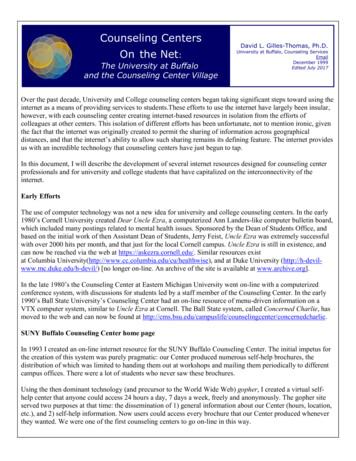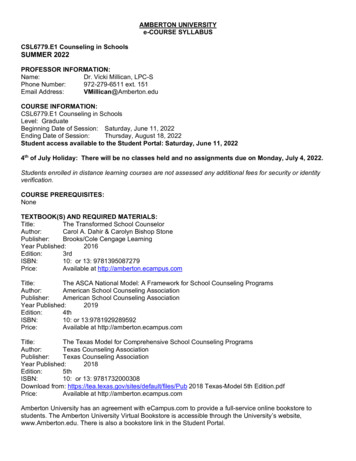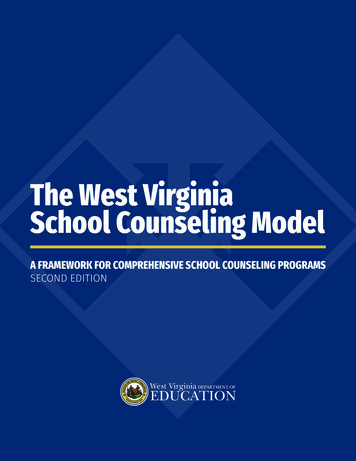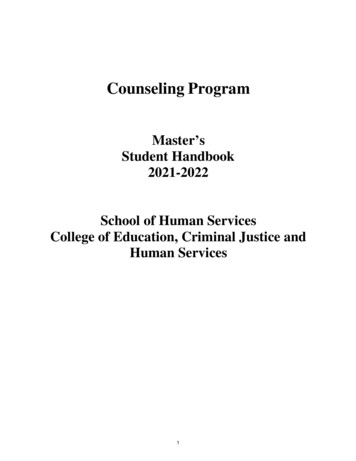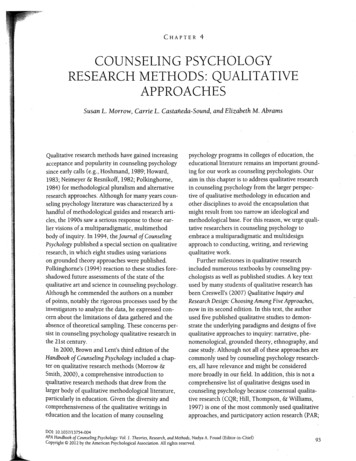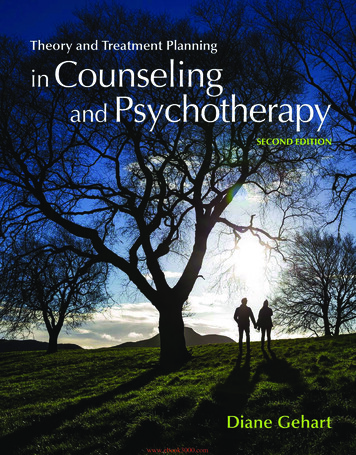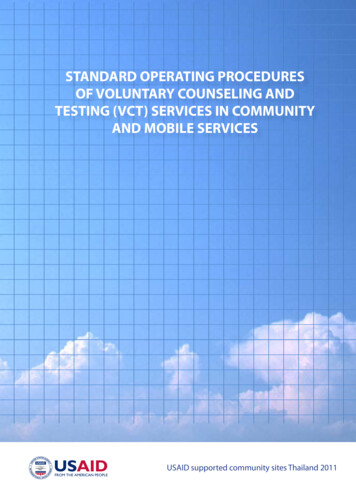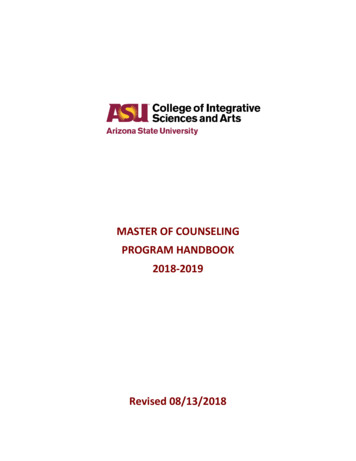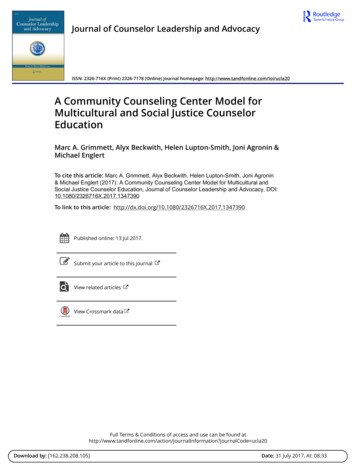
Transcription
Journal of Counselor Leadership and AdvocacyISSN: 2326-716X (Print) 2326-7178 (Online) Journal homepage: http://www.tandfonline.com/loi/ucla20A Community Counseling Center Model forMulticultural and Social Justice CounselorEducationMarc A. Grimmett, Alyx Beckwith, Helen Lupton-Smith, Joni Agronin &Michael EnglertTo cite this article: Marc A. Grimmett, Alyx Beckwith, Helen Lupton-Smith, Joni Agronin& Michael Englert (2017): A Community Counseling Center Model for Multicultural andSocial Justice Counselor Education, Journal of Counselor Leadership and Advocacy, DOI:10.1080/2326716X.2017.1347390To link to this article: lished online: 13 Jul 2017.Submit your article to this journalView related articlesView Crossmark dataFull Terms & Conditions of access and use can be found tion?journalCode ucla20Download by: [162.238.208.105]Date: 31 July 2017, At: 08:33
JOURNAL OF COUNSELOR LEADERSHIP AND 390A Community Counseling Center Model for Multicultural andSocial Justice Counselor EducationMarc A. Grimmett, Alyx Beckwith, Helen Lupton-Smith, Joni Agronin, and Michael EnglertCounselor Education Program, North Carolina State University, Raleigh, NC, USAABSTRACTKEYWORDSThe Community Counseling, Education, and Research Center (CCERC)model addresses a critical public health need for accessible, affordable,high-quality mental health services focused on wellness. Within a southeastern urban community, the multicultural and social justice foundation ofthe model responds to systemic needs and creates an optimal learningenvironment for counselor education graduate students, unavailable intraditional health-care and human service systems. A client study is offeredto demonstrate the application of the model.Counseling practice;counselor education;multicultural issues;prevention/wellness;social justice issuesIntroductionCounseling and mental health are usually only covered in the news and become a part of publicdiscourses following reported tragedies, such as school shootings, a wife being killed by her husband,a mother drowning her children, or when a celebrity has a drug overdose or dies by suicide(McGinty, Kennedy-Hendricks, Choksy, & Barry, 2016). Periodically, there are also reports on theincreasing utilization of emergency services for individuals experiencing a mental health crisis or theoverrepresentation of prisoners with diagnosable mental disorders (Jaffee, 2014). Much less attentionis paid, however, to everyday people dealing with the daily stresses of life, without adequate support,that may contribute to such unfortunate events. While the idea of going to counseling for help withpersonal problems may be initially disconcerting for some, associated costs and health insurancelimitations can make counseling unaffordable and inaccessible for many. Any delays or barriers toreceiving counseling services act as disincentives that result in disengagement from the help-seekingprocess and set the stage for crisis.With an urban North Carolina area as the context, the purpose of this article is to illustrate howcounselor education programs can address both counselor training and community mental healthneeds through community partnerships. First, an overview of the mental health needs of NorthCarolina and clinical training in counselor education are provided. Next, the process for thedevelopment of the Community Counseling, Education, and Research Center (CCERC) and relatedmodel are described. Finally, a client study is presented to illustrate application of the CCERCmodel, followed by implications for implementation and sustainability.Mental health needs of North CarolinaIn the past 20 years, North Carolina has implemented reforms to its public mental health system(Gray, 2009; Rash, 2012). Intended to improve the quality and accessibility of services to the citizensof the state, by-products of these reforms have resulted in the closing of Community Mental HealthCenters (CMHCs) in the state and the privatization of services. CMHCs were transformed intoorganizations that manage behavioral health care by referring clients to private mental healthCONTACT Marc A. Grimmett 2017 Chi Sigma Iotamarc grimmett@ncsu.eduCampus Box 7801, Raleigh, NC, 27695-7801.
2M. A. GRIMMETT ET AL.providers reimbursed by Medicaid. According to Swartz and Morrissey (2012), “one of the unanticipated consequences of this privatization was the increasing fragmentation of services” (p. 180).The fragmentation has created structural barriers often preventing, delaying, or impeding citizensfrom receiving critical mental health services. Many North Carolinians who need services areuninformed about who provides these services and do not understand how to access them (NorthCarolina Institute of Medicine Task Force on Mental Health and Substance Use, 2016). Over half ofadults with mental illness in North Carolina went without treatment from 2009 to 2013 (SubstanceAbuse and Mental Health Services Administration [SAMHSA], 2015). From 2006 to 2013, over 60%of adolescents with depression in the state were not treated (SAMHSA, 2015).In addition to difficulty navigating the complexity of mental health services in the state, lack ofhealth insurance coverage is another major factor obstructing access to mental health care (Creedon& Le Cook, 2016). Close to 20% of adults under 65 in North Carolina have no health insurance(Cone Health Foundation, 2014). Despite the implementation of the Affordable Care Act in 2014,many adults remain uninsured due to North Carolina’s decision to decline federal funding to expandMedicaid, a key provision of the act (United Stated Department of Health and Human Services,2015). Adults who do not have children have been especially hard hit by this decision, as there is noMedicaid coverage available for these individuals in North Carolina (Cone Health Foundation,2014). The North Carolina Institute of Medicine (NCIOM) Task Force on Mental Health andSubstance Use found that “state funding for mental health and substance abuse treatment servicesis inadequate to meet the mental health and substance use treatment and recovery needs of theuninsured and underinsured” (2016, p. 438).Lower-income people of color have also been disproportionately impacted by the state’s decisionnot to expand Medicaid (Creedon & Le Cook, 2016). States that chose not to expand Medicaid havelarger populations of racial and ethnic minorities than states that expanded Medicaid (Creedon & LeCook, 2016). Despite increases in access to mental health treatment for White Americans following theAffordable Care Act in 2014, there were no significant increases for people of color, nor were there anyreductions in racial/ethnic disparities in mental health services (Creedon & Le Cook, 2016). Accordingto the 2010 U.S. Census, 21.5% of North Carolinians identify as Black or African American and 8.4%identify as Hispanic or Latino (of any race). Five years later, 22.9% of Black families and 30.5% ofHispanic families were living below the poverty level (United States Census Bureau, 2015).A lack of sufficient insurance coverage is not the only barrier to mental health treatment forpeople of color. Other barriers include a shortage of practitioners who are willing and/or trained toprovide services to a multicultural population as well as a persistent stigma in many communitiesaround accessing treatment (Creedon & Le Cook, 2016). In addition, preventative, developmental,and wellness components of current mental health care are underemphasized. Individuals experiencing common human issues such as stress, family and relationship challenges, and career difficultiesmust be given a diagnosis for reimbursement purposes, though they often do not meet diagnosticcriteria for a mental disorder (American Psychiatric Association [APA], 2013; Kautz, Mauch, &Smith, 2008). An opportunity to prioritize prevention over treatment is lost due to underfunding forwellness counseling.Clinical training in counselor educationCreating optimal conditions for the clinical training of counselors has been a pertinent topicamong counselor educators since the 1940s (Myers & Smith, 1994). The latest Council forAccreditation of Counseling and Related Educational Programs (CACREP) standards stipulatethat “Professional practice, which includes practicum and internship, provides for the applicationof the theory and the development of counseling skills under supervision” (CACREP, 2016,p. 13). CACREP standards state that professional practice must also include opportunities forcounselors-in-training to familiarize themselves with various nonclinical activities of counseling.Counselor education programs are not required to operate clinics, but space must be created for
JOURNAL OF COUNSELOR LEADERSHIP AND ADVOCACY3training, demonstration, and supervision purposes for either prepracticum or for practicum andinternships (CACREP, 2016). Some programs opt to create clinics for their students to completeprofessional practice activities.Lauka and McCarthy (2013) described Counselor Education and Supervision (CES) trainingclinics as instructional environments set on university campuses or in the community that providecounseling services, allow for professional development for counselors-in-training, and operate inways similar to non-university-run clinics. CES clinics are distinct from counseling laboratories,which are used for role-plays or demonstrations but do not provide services to actual clients (2013).Lauka and McCarthy (2013) asserted that CES clinics “are in a unique position to promote socialjustice within the community” because they fill a gap in the provision of counseling services tomarginalized, underinsured, or uninsured clients (p. 111).Sweeney (2010) discussed the many advantages to developing counselor competence within CEStraining clinics. Two major such benefits are the opportunity for graduate students to discuss clientsdirectly with faculty members and “deliberate opportunities provided for open dialogue about allissues relevant to the conduct of effective counseling services” (2010, p. 45). Additional benefitsinclude: encouraging counseling research into effective professional practice; increasing programcollaboration with local schools, businesses, and agencies; creating an opportunity for doctoralstudents to practice conducting supervision; and promoting faculty and student community advocacy efforts (Sweeney, 2010).A review of the literature on CES clinics highlights the delicate balance such clinics must strike inproviding high-quality counseling to clients while also developing the skills and capacities of graduatestudents (Ametrano & Stickel, 1999; Mobley & Myers, 2010; Myers & Smith, 1994, 1995). A potentialfor conflict exists between the two major objectives of training and service. Mobley and Myers (2010)argued that ethical conflicts arise when clinics try to provide both training and clinical services. Staffcoverage during university breaks and summers, criteria for matching clients with counselors-intraining, and requirements for recording counseling sessions are potential areas in which conflict canarise between training and service (Mobley & Myers, 2010; Myers & Smith, 1994).Hittner and Fawcett (2012) created a CES clinic at Winona State University in Minnesota andargued that, instead of conflicting, the two goals of training and service are complementary.Counseling students at a CES clinic have the opportunity to serve the college and the widercommunity while also building knowledge, expertise, and skills (Hittner & Fawcett, 2012).Ametrano and Stickel (1999) addressed the ethical issues of conducting training and service andoffered an accountability model to enhance evaluation at CES clinics. Their model is derived fromthe work of Rossi and Freeman (1993) and Hadley and Mitchell (1995) and consists of six categoriesof accountability measures that CES clinics should meet. The six categories—service delivery,coverage, impact, legal, efficiency, and ethical accountability—cover many facets of clinic operationsand interventions (Ametrano & Stickel, 1999). Although the measures are useful for the developmentof CES clinics, the model is slightly outdated.In a more recent effort to ensure the ethical and efficient operation of CES clinics, Lauka andMcCarthy (2013) advocated for the development of CACREP standards for clinics and proposedguidelines. Building on the work of Myers and Smith (1994, 1995), Ametrano and Stickel (1999), theAmerican Counseling Association (ACA), the Association for Counselor Education and Supervision(ACES), and psychologists regarding training clinics, Lauka and McCarthy (2013) devised guidelinesfor: (a) clinic mission, (b) clinic director and other staff, (c) clinic operations, and (d) supervision.The aspirational guidelines provide a useful model for operations.Among recommendations for CES clinics is the standardization of hiring practices for all staffmembers, including listing specific responsibilities, holding new employee orientation, and conducting continuous evaluation of performance (Lauka & McCarthy, 2013). The guidelines also stipulatethat termination and/or referral procedures should be developed if the clinic does not operate yearround and that policies should be created to manage enrollment of new clients and communityoutreach (Lauka & McCarthy, 2013).
4M. A. GRIMMETT ET AL.Despite the development of how-to guides for operating CES clinics, a review of the literaturereveals that there is limited information available on the number of counselor training clinics thatexist and how they are being administered (Mobley & Myers, 2010). While a specific number offunctioning clinics could not be found by searching the literature, there is information about the lackof CES in many programs and discussion regarding what hinders the development of clinics (Bobby& Urofsky, 2010; Hittner & Fawcett, 2012). According to Bobby and Urofsky (2010), “CACREPrecognizes that, while some programs choose and are able to invest resources in on-campus clinics,many programs do not receive the necessary support from the institution to do so” (p. 37). This maybe of particular concern among small, private schools with limited funding. In addition to significantfinancial costs and university support needed to run a CES, additional barriers to opening a clinicinclude insufficient space for client services, limited number of qualified supervisors to train master’sstudents (Hittner & Fawcett, 2012), and a lack of time to market counseling services (Sweeney,2010). What follows describes the process of developing a counselor education program-basedcommunity counseling clinic in spite of these challenges.Community Counseling, Education, and Research Center (CCERC)The development of the Community Counseling, Education, and Research Center (CCERC) can beconceptualized in three phases: foundation, refinement, and expansion. Foundational tasks includedarticulating the mission and vision, acquiring a community space, creating a plan for staffing andsupervision of interns, recruiting and assigning clients, and formalizing center structure and procedures including the website and handbook. The name center was chosen, instead of clinic, which hasa negative connotation in some communities and is also closely associated with the medical model(Larson, 1999). Center is more reflective of the multidimensional nature of CCERC and aligns betterwith a wellness model (Myers & Sweeney, 2008). In the refinement phase, the physical space of thecenter was improved with new furniture and carpet as financial support increased from communityand university partners. Additionally, center procedures and processes were more structured andefficient (i.e., supervision, training, client referrals, applying for CCERC internship). Finally, theexpansion phase includes plans to transition into a larger space, secure additional funding throughthe support of the community and university partnerships, and increase the number of studentstrained and clients served. CCERC is the home base for the application of the correspondingconceptual model (i.e., The CCERC Model).The CCERC modelThe CCERC mission is to provide world-class community counseling and develop counselors andsupervisors for multicultural and social justice practice (Grimmett, Lupton-Smith, Beckwith, &Englert, 2016). CCERC defines world-class community counseling as an aspirational ideal to: (1) provideexcellent mental health services within communities, informed by: (a) love ethic (Hooks, 2000), (b)wellness focus (Myers & Sweeney, 2008), (c) multiculturalism and social justice (Ratts, Singh, NassarMcMillan, Butler, & McCullough, 2015), and (d) research and scholarship (CACREP, 2016); and (2)make positive contributions to community mental health models across the world (Stanard, 2013).The multidimensional, dynamic, and collaborative CCERC model is uniquely valuable to thecommunity when compared to community mental health centers, private practices, and hospitals.Specifically, the CCERC model has three foundations—identity, community, and structure—consisting of 14 synergistic and layered components that operationalize the identity and values of thecounselor education program in which it is housed as well as reflect the overarching professionalvalues of counseling and counselor education. The components, defined in Table 1 and discussedwithin the following three foundations, are not always readily available in traditional health-care andhuman services systems.
JOURNAL OF COUNSELOR LEADERSHIP AND ADVOCACY5Table 1. CCERC model foundations, components, and description.FoundationComponentIdentityWorld-class StandardLove EthicWellness FocusMulticulturalism andSocial JusticeResearch andScholarshipCommunity Community WorldviewCommunity PartnerCommunity LocationCommunity OutreachStructurePublic DoctoralUniversityCounselor EducationProgramGraduate StudentsCounselor EducatorsSliding Fee ScaleDescriptionAspirational community counseling model that informs all others and is among the bestin the world.Utilization of all dimensions of love–care, commitment, trust, responsibility, respect, andknowledge– in the everyday work of the center. Presupposes that everyone has the rightto be free, to live fully and well.Attends to the physical, psychological, social, cultural, emotional, relational, and spiritualdevelopmental needs, rather than focus solely on mental illness.Follows Multicultural and Social Justice Counseling Competencies. Counselors andsupervisors trained to work with diverse clients of diverse cultural backgrounds andpersonal identities.Counselor and supervisor training, and counseling services are regularly assessed toenhance quality and effectiveness; Assessment information is used for communityengaged scholarship, research, counselor education, advocacy, and innovation.Affirming recognition of the interconnection and interdependence between humanbeings and the environment; collective responsibility.Collaborative partnership with local non-profit organization that provides communitymembers with opportunities for achievement, enrichment, and service in preparation forpersonal and academic success.Shared, accessible (i.e., bus route, sidewalks, parking, first floor) physical space (i.e.,building) with non-profit partner located within community (i.e., not on the universitycampus).Intentional and standardized community outreach, relationship development,information sharing, and advertising to make public aware of services.Affiliated with highest research activity university.Operated by CACREP accredited counselor education program for advanced counselingand supervision internship courses.Master's and doctoral student intern counselors, supervisors, coordinators, and researchassistants provide all center services under supervision of counselor education faculty.Faculty direct the center, provide supervision, and work directly with clients, asconsultants and co-therapists with counselor interns.Costs of services match what clients are able to afford, from 0- 30 per counseling hour,based on self-reported client income.IdentityThe CCERC model champions accessible, affordable, and high-quality health care as a human right.Following social justice principles, income, class, or background should not restrict access to excellentmental health and career counseling services. In this way, world-class counseling services are providedto uninsured, underinsured, underserved, and marginalized community members.Both the mission and model address a critical public health need for holistic health care, whichincludes mental health and counseling services focused on prevention, development, and wellness. Awellness model allows for individuals to participate in counseling to benefit their health, similar tohealthy eating and exercise, as well as the opportunity to address mental health issues. Myers andSweeney (2008) explained that “health in this context is a neutral concept, with wellness defined as apositive state of well-being on a continuum that ranges from illness at one extreme, through healthin the middle, to high-level wellness at the other extreme” (p. 482). With a focus on prevention,development, and well-being, counselors at CCERC incorporate holistic approaches that attend tothe physical, psychological, social, cultural, emotional, relational, and spiritual needs of clients. Theprimary goal is to prevent emotional distress and impairment in functioning by engaging incounseling for wellness.CCERC strives to achieve these objectives through outreach that includes: (a) prevention andearly intervention in communities (e.g., information sharing at community events, activereferral partnerships with schools and community agencies); (b) accessibility structure andstrategies that address barriers to services, which disproportionately affect people of color andlower-income groups (e.g., center location, cost, cultural competence); and (c) a formal,
6M. A. GRIMMETT ET AL.collaborative partnership with a local nonprofit organization, the Wade Edwards Foundationand Learning Lab (i.e., WELL), which serves high school students and community members andprovides opportunities for achievement, enrichment, and service in preparation for personal andacademic success.Research on the CCERC model, including qualitative and outcome measurements is in theimplementation stage. Studying the model is required to: (a) understand the quality of servicesprovided by CCERC; (b) measure and follow client progress; and (c) assess, plan, and improve theCCERC model and services for ongoing improvement and continuous development. The WorldHealth Organization Quality of Life Brief (WHOQOL-Bref; The WHOQOL group, 1998) will be usedto assess and monitor the quality of life and wellness of clients receiving services at CCERC. Clientexperience and satisfaction will be assessed using the CCERC Client Questionnaire (i.e., quantitative,Likert scale; Grimmett et al., 2016) and the CCERC Model Questionnaire 5 (i.e., five qualitativequestions; Grimmett et al., 2016). Early indicators of effectiveness include: the number of sessionscompleted per client, steady increase in client revenue, consistent increase in new referrals, andqualitative accounts of positive and helpful client experiences voluntarily self-reported by clients tocounselors and reported by community partners. Practicum and internship course evaluations alsoendorse the multidimensional learning opportunities provided by the model.CommunityThe second foundation of the CCERC model is a focus on community. A community worldviewrecognizes connections, shares resources, and builds collaborative partnerships. The collaborationbetween CCERC and the WELL, for example, offers students served by the WELL and communityclients experiences to grow culturally and holistically, while allowing graduate students opportunitiesfor advanced counselor training.In efforts to provide needed resources to the community, Constantine, Hage, Kindaichi, andBryant (2007) discussed the social justice competencies that are essential for counselors to considerwhen working in community settings. Among the recommendations are the following:Conceptualize, implement, and evaluate comprehensive preventive and remedial mental health interventionprograms that are aimed at addressing the needs of marginalized populations; collaborate with communityorganizations in democratic partnerships to promote trust, minimize perceived power differentials, and provideculturally relevant services to identified groups. (p. 26)The WELL provides programming that fulfills a social justice mission, such as free tutoring,college preparation, and community service programs that typically serve underresourced studentsof color experiencing academic and personal challenges as well as job-training programs for adults.Individual, couples, family, career development, and health and wellness counseling services areprovided at CCERC and available to community members who are self-referred or referred bycommunity partners such as schools, university counseling center, private practice, and humanservices agencies. Clients are also considered partners and are oriented to this worldview during theinformed consent process, as their engagement in counseling services makes training counselingstudents possible.StructureMany community mental health agencies depend on third-party reimbursement, which oftenrequires that clients be given a diagnosis for payment of services rendered. With the CCERCmodel, formal diagnoses are not required and are often unnecessary for people to engage in thecounseling process. In lieu of third-party reimbursement, CCERC encourages clients to pay whatthey choose according to a sliding scale based on income. Fees collected are used to support theoperation of the center (e.g., office supplies, marketing, training and research materials). The fees
JOURNAL OF COUNSELOR LEADERSHIP AND ADVOCACY7contribute to long-term sustainability of the center within the college, university, and communityand instill in counseling students the notion that counseling services warrant financial compensation(i.e., some students are initially uncomfortable accepting payment for services). At CCERC, theimplementation of a sliding scale fee shows respect for the agency of the clients receiving services(i.e., paying for services can help promote a more egalitarian relationship between counselor andclient) and also makes explicit the financial value of counseling services (i.e., particularly, whencompared to the typical cost of counseling services within the community.The process for receiving counseling services involves the client contacting CCERC by phone orcompleting an online contact information form. The doctoral student center coordinator contacts theclient for a phone interview to determine appropriateness of fit for CCERC services. Individuals withsevere and persistent mental illnesses or who pose a threat to safety for self or others would not beappropriate referrals, as CCERC does not provide comprehensive mental health services (e.g., on-callcounselor, psychiatry, 24-hour crisis support). Counseling areas include, but are not limited to, workand career, stress, anxiety, depression, family, relationships, trauma, identity, and LGBTQI issues.Practicum and internship at CCERCThe development component of the CCERC mission requires providing an optimal learning environment for counselor education graduate students that is enabled by the service component. Both partsof the mission, together with the components of the CCERC model, support and facilitate multicultural and social justice counseling competency of the graduate students and center operations as awhole (Ratts et al., 2015; Sue, Arredondo, & McDavis, 1992). Master’s- and doctoral-level counseloreducation students, enrolled in counseling practicum, internship, and supervision courses taught bycounselor education faculty, provide the counseling services at CCERC. Two program faculty membersserve as CCERC codirectors and supervise two doctoral student center coordinators and all centeroperations (e.g., weekly administrative, clinical and research meetings, trainings, supervision, development). The whole counselor education faculty is involved in major decisions related to CCERC.A relational-collaborative organizational structure is practiced within CCERC, which followsmulticultural and feminist principles of value and equality of all staff members. CCERC responsibilities and tasks are divided flatly according to staff roles (i.e., faculty codirectors, graduateassistants, interns), rather than hierarchically, with the clear expectation that all members areexpected to contribute their unique talents to our working community. Finally, all CCERC membersare responsible for forming, nurturing, and sustaining community partnerships, which ultimatelymake services more accessible and provide additional CCERC resources.As per the recommendations for counselor education and supervision clinics put forth by Laukaand McCarthy (2013), graduate assistants who serve as coordinators are provided with specific jobresponsibilities and agree to them before accepting their positions. An orientation for interns and/orpracticum students is held at the beginning of each academic semester (i.e., Fall, Spring, Summer) totrain new students on the mission, vision, policies, and procedures of CCERC. After 1.5 years ofoperation, six doctoral and nine master’s students received one to three semesters of clinical trainingat CCERC. The following client study illustrates an application of the CCERC model.CCERC model client studyAfter CCERC partnered with the WELL, the executive director organized a meeting with studentsupport services at the public high school acros
& Michael Englert (2017): A Community Counseling Center Model for Multicultural and Social Justice Counselor Education, Journal of Counselor Leadership and Advocacy, DOI: 10.1080/2326716X.2017.1347390 . is inadequate to meet the mental health and substance use treatment and recovery needs of the uninsured and underinsured" (2016, p. 438).

